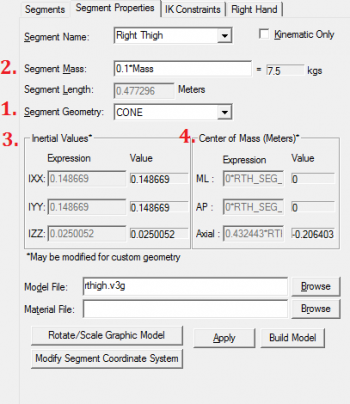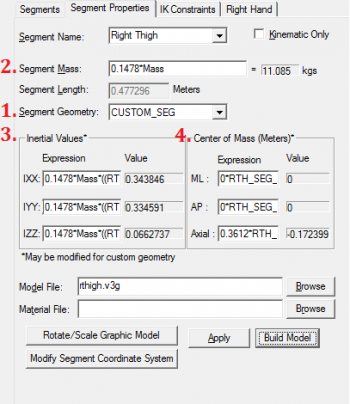Adjusted Zatsiorsky-Seluyanov's segment inertia parameters
| Language: | English • français • italiano • português • español |
|---|
While the original Zatsiorsky-Seluyanov segment inertia parameters (1983) used bony landmarks as reference points, de Leva (1996) adjusted these parameters using joints centres instead, more commonly used in biomechanics. This page lists these adjusted parameters and describes how to used them in Visual3D.
Segment Mass
| Segment | Female | Male |
|---|---|---|
| Head | 0.0668 | 0.0694 |
| Trunk | 0.4257 | 0.4346 |
| Upper arm | 0.0255 | 0.0271 |
| Forearm | 0.0138 | 0.0162 |
| Hand | 0.0056 | 0.0061 |
| Thigh | 0.1478 | 0.1416 |
| Shank | 0.0481 | 0.0433 |
| Foot | 0.0129 | 0.0137 |
- Relative to total body mass.
Segment Centre of Mass Location
| Segment | Female | Male |
|---|---|---|
| Head | 0.4841 | 0.5002 |
| Trunk | 0.4964 | 0.5138 |
| Upper arm | 0.5754 | 0.5772 |
| Forearm | 0.4559 | 0.4574 |
| Hand | 0.7474 | 0.7900 |
| Thigh | 0.3612 | 0.4095 |
| Shank | 0.4352 | 0.4395 |
| Foot | 0.4014 | 0.4415 |
- Relative to the segment's proximal endpoint.
Segment Radii of gyration
| Segment | Female | Male | ||||
|---|---|---|---|---|---|---|
| IXX | IYY | IZZ | IXX | IYY | IZZ | |
| Head | 0.271 | 0.295 | 0.261 | 0.303 | 0.315 | 0.261 |
| Trunk | 0.307 | 0.292 | 0.147 | 0.328 | 0.306 | 0.169 |
| Upper arm | 0.278 | 0.260 | 0.148 | 0.285 | 0.269 | 0.158 |
| Forearm | 0.261 | 0.257 | 0.094 | 0.276 | 0.265 | 0.121 |
| Hand | 0.631 | 0.454 | 0.335 | 0.628 | 0.513 | 0.401 |
| Thigh | 0.369 | 0.364 | 0.162 | 0.329 | 0.329 | 0.149 |
| Shank | 0.267 | 0.263 | 0.092 | 0.251 | 0.246 | 0.102 |
| Foot | 0.299 | 0.279 | 0.139 | 0.257 | 0.245 | 0.124 |
Modifying the Inertial Values using the Adjusted Zatsiorsky-Seluyanov's parameters
Below is on image the default segment properties (on left) and the modified segment properties (on right). The modified segment properties reflect Zatsiorsky's adjusted segment properties for a female's right thigh.
|
ORIGINAL |
MODIFIED |
1 - Change the segment geometry to CUSTOM_SEG
2 - To modify the Mass, replace the mass factor from the current equation (0.1* Mass) to Zatsiorsky-Seluyanov mass value(For example: "0.1478 * Mass" for a female thigh segment).
3 - To modify the Inertia Values, the expression has to be entered as: "m*r^2"
Where m is the segment's mass parameter, and r is the IXX, IYY or IZZ radius of gyration parameter. The radius of gyration in De Lava's paper is presented as a percent of segment length, so this value must be multiplied by the length of the segment.
For example, to use the Zatsiorsky-Seluyanov's Inertia Values for the right thigh for a female subject, the following expressions would have to be entered in the IXX, IYY and IZZ fields.
IXX = ( 0.1478*Mass ) *((RTH_SEG_LENGTH * 0.369 )^2)
IYY = ( 0.1478*Mass ) *((RTH_SEG_LENGTH * 0.364 )^2)
IZZ = ( 0.1478*Mass ) *((RTH_SEG_LENGTH * 0.162 )^2)
4 - To modify the location of the center of mass according to Zatsiorsky-Seluyanov's parameters, replace the factor from the current equation (0.444004 * RTH_Seg_Length in the above image) with the corresponding Centre of Mass location parameter (for example: "0.3612 * RTH_Seg_Length" for a female thigh segment).
- The segment length (RTH_SEG_LENGTH) is listed under the Subject Data / Metrics tabs. This value is automatically created when a segment is created.
Reference
de Leva (1996) Adjustements to Zatsiorsky-Seluyanov's segment Inertia Parameters. Journal of Biomechanics Vol.29 No. 9. pp.1223-1230.

